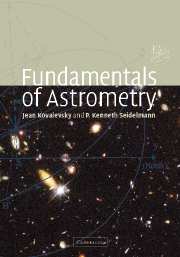Book contents
- Frontmatter
- Contents
- Preface
- List of abbreviations
- 1 Introduction
- 2 New observational techniques
- 3 Basic principles and coordinate systems
- 4 Treatment of astronomical data
- 5 Principles of relativity
- 6 Apparent displacements of celestial objects
- 7 Extragalactic reference frame
- 8 Dynamical reference frame
- 9 Terrestrial coordinate systems
- 10 Earth orientation
- 11 Stars
- 12 Double and multiple star systems
- 13 Astronomical phenomena
- 14 Applications to observations
- Appendix A Examples
- Appendix B Astronomical values
- Glossary
- References
- Index
7 - Extragalactic reference frame
Published online by Cambridge University Press: 05 November 2011
- Frontmatter
- Contents
- Preface
- List of abbreviations
- 1 Introduction
- 2 New observational techniques
- 3 Basic principles and coordinate systems
- 4 Treatment of astronomical data
- 5 Principles of relativity
- 6 Apparent displacements of celestial objects
- 7 Extragalactic reference frame
- 8 Dynamical reference frame
- 9 Terrestrial coordinate systems
- 10 Earth orientation
- 11 Stars
- 12 Double and multiple star systems
- 13 Astronomical phenomena
- 14 Applications to observations
- Appendix A Examples
- Appendix B Astronomical values
- Glossary
- References
- Index
Summary
In Section 1.4 we stated that astrometry must be developed within an extragalactic reference frame to microarcsecond accuracies. The objective of the present chapter is to provide the theoretical and practical background of this basic concept.
International Celestial Reference System (ICRS)
A reference system is the underlying theoretical concept for the construction of a reference frame. In an ideal kinematic reference system it is assumed that the Universe does not rotate. The theoretical background was presented in Section 5.4.1. The reference system requires the identification of a physical system and its characteristics, or parameters, which are determined from observations and that can be used to define the reference system. In 1991 the International Astronomical Union agreed, in principle, to change to a fundamental reference system based on distant extragalactic radio sources, in place of nearby bright optical stars (IAU, 1992; IAU, 1998; IAU, 2001). The distances of extragalactic radio sources are so large that motions of selected objects, and changes in their source structure, should not contribute to apparent temporal positional changes greater than a few microarcseconds. Thus, positions of these objects should be able to define a quasi-inertial reference frame that is purely kinematic. A Working Group was established to determine a catalog of sources to define this frame that is now called the ICRF.
Information
- Type
- Chapter
- Information
- Fundamentals of Astrometry , pp. 157 - 170Publisher: Cambridge University PressPrint publication year: 2004
